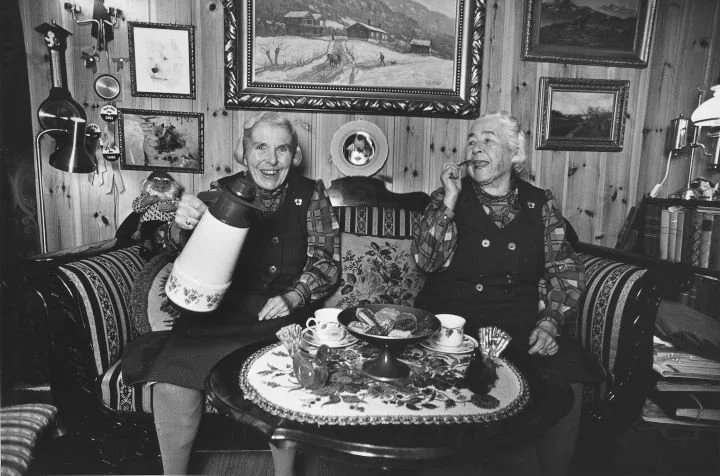The fancy finish line
Retirement looks fun. (Arkivverket)
The idea of “passive income” is oh-so-tempting.
Build a thing once — a digital product or an affiliate website or an apartment building — and then people will buy it again and again. Make money while you sleep!
What this fantasy leaves out is the amount of work required to not just build the thing in the first place, but to create the entire ecosystem that will allow it to be found by the people who will want to buy it.
Oh, and...the clarity to know what you want to create, the confidence to follow through on something when there is no guarantee of success, and the skills needed to actually do it.
It’s important to remember, when we’re looking at successful people, that where they are now is not where they began.
And some of the people who teach this kind of thing forget that, too.
Instead of teaching you how to start where you are and grow from there, they give you the formula based on what they have now. Ironically, that makes the path longer and less accessible. That’s because your path isn’t just from where you are now to the starting point so that you can run the race. Instead, you’re trying to get all the way to the fancy finish line without even realizing it’s the finish line. Or that it’s fancy.
Seeking the end result when you’re still at the beginning makes everything harder and more frustrating. It’s also unnecessarily costly.
For example, let’s consider a couple in their seventies, one an artist and one an academic. Maybe they bought their home in Somerville, Massachusetts, in 1980. Surrounded by prestigious colleges and universities, they have thrived in this culturally and intellectually stimulating environment. They’ve amassed an impressive collection of books, art, and vinyl records.
The home they bought in 1980 for $40,000 (about $143,772 when adjusted for inflation) is now worth over a million. The books, art, and music, as a whole, are priceless.
The classic architecture, the lived-in feeling, the signs of impeccable taste — a grad student walking through this couple’s home might look around and think, “This is what I want.”
But for that grad student to buy the same house with the same stuff in it would cost a fortune and the efforts of an entire team of interior designers to scour antique shops, vintage bookstores, and eBay listings.
The grad student might have a chance of achieving a similar result if she buys today in a dumpy, declining town no one wants to live in (like Somerville was in 1980) and spends the next four decades in a normal cycle of buying a few things every month. Saving up from scratch to buy a $1.2 million home in Somerville is probably not viable.
The most impressive results usually come from investment. The only way to make such an investment is steady effort over time. Attempting to leap over that investment and reap the reward causes us to become overextended, demoralized, and often broke.
I see the same thing when it comes to people working to build businesses. They see someone else’s beautiful head shots, fancy logo, slick website, well-developed library of products and services, mountains of testimonials, and flawless video presentations and think, “that’s what I need.” So they try to develop all of those things in order to begin.
But that’s like thinking that you need a Pinterest-worthy, marble-countertopped, stainless-steeled kitchen in order to cook a meal. You don’t — you can do it in a kitchen like mine, with Formica countertops from 1969, appliances from 1989, and a pantry that has consisted of a Rubbermaid tub since an army of mice invaded the real pantry the summer of 2021. The food will take just as good.
We have to start where we are. Large sums of money can provide a shortcut; for the rest of us, we have to invest to build equity. Hard as we try, we just can’t know the end in the beginning. We have to go through the painful process of figuring things out along the way.
Eventually, you gather the pieces that you hoped you’d find. But it takes what it takes. You can’t judge yourself against where you want to end up. The pieces someone has in place at a point of maturity in the cycle do not need to be present in the early days.
Jeff Lynne has a lovely song romanticizing his early years called “When I Was A Boy.” The lyrics go, “...radio waves kept me company/in those beautiful days when there was no money.” He wasn’t born a rock star. It wouldn’t have been any fun to be a rock star if he had been. There was joy in dreaming of the future, and joy in making that future come true — and now, joy in the sense of wistfulness for the time before he knew how it was going to turn out.
It would be nice to be able to avoid the uncertainty of not knowing how it’s going to turn out and skip to the part where we look the part and embody everything we are hoping to be. However, not only is that the expensive way to go, I would argue that it’s not as rewarding. Isn’t the journey what makes the whole experience worthwhile?
If we’re patient and persistent, we will make progress and fill in all of the gaps. But we don’t need to have all of those gaps filled in when we launch; what’s more, if we did, we’d miss out on the satisfaction of filling them in. Why rush it?





